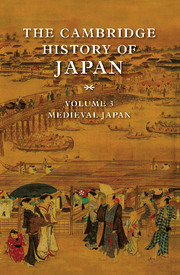Book contents
- Frontmatter
- Introduction
- 1 The Kamakura bakufu
- 2 Medieval shōen
- 3 The decline of the Kamakura bakufu
- 4 The Muromachi bakufu
- 5 Muromachi local government: shugo and kokujin
- 6 The decline of the shōen system
- 7 The medieval peasant
- 8 The growth of commerce in medieval Japan
- 9 Japan and East Asia
- 10 CULTURAL LIFE IN MEDIEVAL JAPAN
- 11 The other side of culture in medieval Japan
- 12 Buddhism in the Kamakura period
- 13 Zen and the gozan
- Works cited
- Glossary
- Index
- References
7 - The medieval peasant
Published online by Cambridge University Press: 28 March 2008
- Frontmatter
- Introduction
- 1 The Kamakura bakufu
- 2 Medieval shōen
- 3 The decline of the Kamakura bakufu
- 4 The Muromachi bakufu
- 5 Muromachi local government: shugo and kokujin
- 6 The decline of the shōen system
- 7 The medieval peasant
- 8 The growth of commerce in medieval Japan
- 9 Japan and East Asia
- 10 CULTURAL LIFE IN MEDIEVAL JAPAN
- 11 The other side of culture in medieval Japan
- 12 Buddhism in the Kamakura period
- 13 Zen and the gozan
- Works cited
- Glossary
- Index
- References
Summary
Historians generally date the medieval period in Japanese history as starting at the end of the twelfth century when the Kamakura bakufu was established, marking the emerging dominance of warrior government over aristocratic rule. In peasant history, however, the latter half of the eleventh or early twelfth century, however, is a more appropriate point of division between the ancient and medieval periods. The shōen system of land control had extended throughout Japan around that time, bringing entirely new conditions for the peasants and making them henceforth truly “medieval.” The introduction and development of the shōen system had a much greater impact on the living conditions of peasants in Japan than did the founding of the Kamakura bakufu nearly a century later. The shōen system, therefore, is of great significance in peasant history and is the central defining characteristic of the medieval period.
The momentous changes for the peasants brought about by the shōen system must be understood in the context of the earlier conditions pertaining to the land of the ritsuryō system in the eighth century. Under the ritsuryō system, the central government claimed ownership of all land; cultivators were allotted paddies on an equitable basis; and taxes were collected according to specific categories of goods; for example, grain, labor, and silk. But these conditions began to break down rapidly early in the tenth century and had disintegrated entirely by the time the shōen system had spread throughout Japan in the late eleventh and early twelfth centuries.
- Type
- Chapter
- Information
- The Cambridge History of Japan , pp. 301 - 343Publisher: Cambridge University PressPrint publication year: 1990
References
- 2
- Cited by



